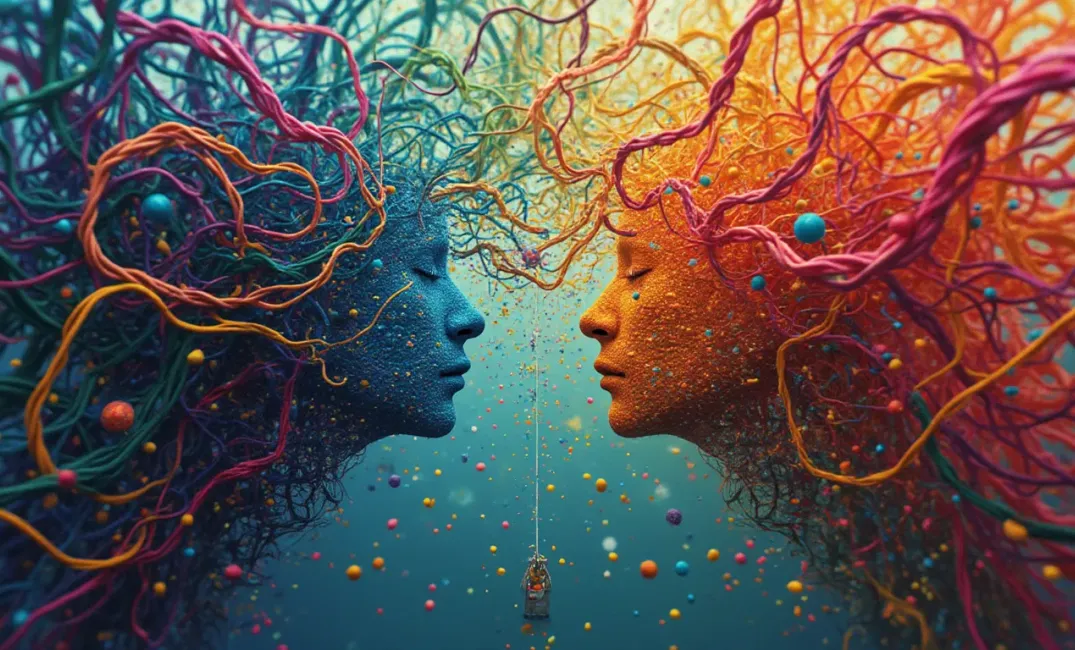Introduction: The Many Faces of Emotion
Human emotions are as ancient as humanity itself, a kaleidoscope of experiences that shape perceptions, actions, and connections. The study of emotions unveils their role in guiding cultural evolution, personal choices, relationships, and societal transformations. This entry embarks on a journey through the alchemy of human emotions—seeking to understand how they intertwine joy, anguish, empathy, and everything in between, offering a lens through which the human experience is continuously crafted and interpreted.
"Human emotions are the soul's compass, guiding us through the labyrinth of existence with whispers of true north and tales of forgotten realms." — Author Unknown
The Birth of Emotions: Primitive Roots and Biological Beginnings
Evolutionary Origins
- Primal Instincts and Survival: Emotions initially evolved as instinctual responses to environmental stimuli, essential for survival and adaptive behaviors. Fear, for instance, triggered by threats, ensured vigilance, while pleasure from nourishment encouraged sustenance.
- Hardwiring Complexities: Research in neuroscience points to limbic system structures—amygdala, hippocampus—as core components managing emotional responses, creating intrinsic links between memory, emotion, and decision-making, showcasing brain architecture's role in emotional evolution.
Emotional Expressions: Universality Amid Diversity
- Facial Expression Insights: Studies spearheaded by psychologists like Paul Ekman have demonstrated that emotions manifest similarly across diverse cultures through universal facial expressions—joy, sadness, anger, surprise—illustrating shared human emotional experiences.
- Cultural Nuances and Contexts: However, cultural settings dictate emotional expression norms, shaping the articulation and interpretation of emotions within societies, where some cultures encourage overt expressiveness while others value stoicism.
The Spectrum of Emotions: From Joy to Despair
Joy and Happiness: The Pursuit of Well-being
- Elixirs of Happiness: Joy is a powerful motivator, influencing mental health and social bonds. Positive emotions enhance creativity and problem-solving, fostering resilience and adaptability amidst challenges.
- Hedonic and Eudaimonic Pioneers: Philosophical discussions differentiate between hedonic happiness—derived from pleasure—and eudaimonic happiness—arising from purpose and meaningful engagements, shaping dialogues across psychology and existential inquiry.
Anguish and Sadness: Navigating Stormy Seas
- Evolutionary Roles of Negative Emotions: Emotions like fear and sadness play evolutionary roles, prompting caution and introspection. They incite learning from failures, bolstering survival behaviors through adaptive responses.
- Psychosocial Impacts: Prolonged negative emotions contribute to mental health challenges, affecting well-being and societal dynamics. Recognizing emotional pain fortifies collective empathy and destigmatizes mental health discourses.
Anger and Resilience: Forces for Change
- Constructive Energies: While anger can lead to conflict, it also catalyzes positive change by confronting injustices and inspiring societal movements. Its management dictates potential as a tool for advocacy and reform.
- Contextual Emphases: Understanding triggers and context—personal boundaries, perceived violations—enhances anger-related communication, transforming this powerful emotion into an engine of progress rather than destruction.
Cultures of Emotional Expression
Art and Emotion: A Timeless Partnership
- Artistic Depictions: Throughout history, emotions find profound expression in art, from ancient mythological sculptures to contemporary digital illustrations. Artists harness emotions as muses, channeling them into visual, auditory, and written forms.
- Resonance and Rejection: Artistic works enable audiences to explore and confront their emotions, providing spaces for collective emotional catharsis or highlighting societal vulnerabilities, fostering greater emotional literacy.
Emotional Landscapes within Society
- Cultural Emotional Styles: Societal norms influence emotion expression, shaping public discourses and behaviors. Cultures revered for 'emotional collectivism' emphasize community needs, while 'individualistic' societies often prioritize personal affect.
- Language and Emotion: Language intricacies—words, expressions—are pivotal in conveying emotional subtleties. Words uniquely capture cultural emotional landscapes, informing emotion perception and narratives through diverse linguistic structures.
Emotion in Modernity: Technology and Emotional Realities
Digital Emotions: Connectivity or Isolation?
- Social Media's Dual Role: Digital platforms like social media offer ecosystems of emotional connection and expression but also propagate superficial interactions and emotional fatigue. Online interactions blur traditional boundaries, complicating emotional articulation.
- Virtual Expression Forms: Emojis, memes, and digital art represent new emotional languages accommodating instant communication; however, their effectiveness boasts challenges in translation, maintaining authenticity and fostering empathy through constrained communication formats.
AI and Emotional Intelligence: The Technological Intersection
- Affective Computing: Advances in AI technology target emotion recognition and response, creating future possibilities for emotionally intelligent machines that enhance empathetic human-computer interactions and academic interventions in mental healthcare.
- Ethical Paradigms: Emotional AI introduces ethical dilemmas concerning privacy, authenticity, consent. Integrating emotional understanding necessitates ethical frameworks navigating the complexities tied to technology and human emotion intersections.
Emotional Horizon: Future Role and Understanding of Emotions
Neuroscience and Emotional Research
- Neuroemotional Advancements: Expanding research into brain chemistry, neuroplasticity illuminates emotional regulation processes and coping mechanisms for mental health conditions, employing innovative therapeutic interventions enhancing emotional resilience.
- Cinematic and Dialogic Narratives: Encouraging dynamic portrayals of emotions in visual mediums and dialogues promotes acceptance, understanding, framing emotions as integral contributors to authenticity and societal progression in evolving narratives.
Cultivating Emotional Literacy
- Emotion Education Paradigms: Enhancing emotional literacy through education fosters empathy, emotional intelligence, well-being. Incorporating tools like mindfulness and emotional regulation fortifies collective emotional voracity via curricula across generations.
- Community Healing Through Collaborative Efforts: Communities leverage emotions as instruments for healing fractured relationships and promoting global unity, demonstrating resilience and harmony by integrating diverse emotional narratives within shared socio-emotional ecosystems.
Conclusion: The Infinite Alchemy of Emotions
Emotions are intricate tapestries weaving the fabric of human life, a perennial testament to the complex interplay of joy, anguish, and empathy. Understanding and embracing our emotional nature enables us to navigate the vast human experience with compassion, resilience, and genuine connection.
In pursuing future frontiers, let us remember emotions as invaluable guides, reflecting society's sensitivities and moral compass, ensuring well-being and enriching human interactions. Through interpreting emotions as a profound alchemical process, catalyzing transformation and unity, we continue humanity's journey towards understanding the kaleidoscope of what it means to live, relate, and aspire.
"Emotions are the brushstrokes upon the canvas of humanity, painting the ever-evolving portrait of our existence with hues of joy, sorrow, and compassion." — Author Unknown
EMOTIONS, EMPATHY, TECHNOLOGY, PSYCHOLOGY, NEUROSCIENCE, EVOLUTION, CULTURE

